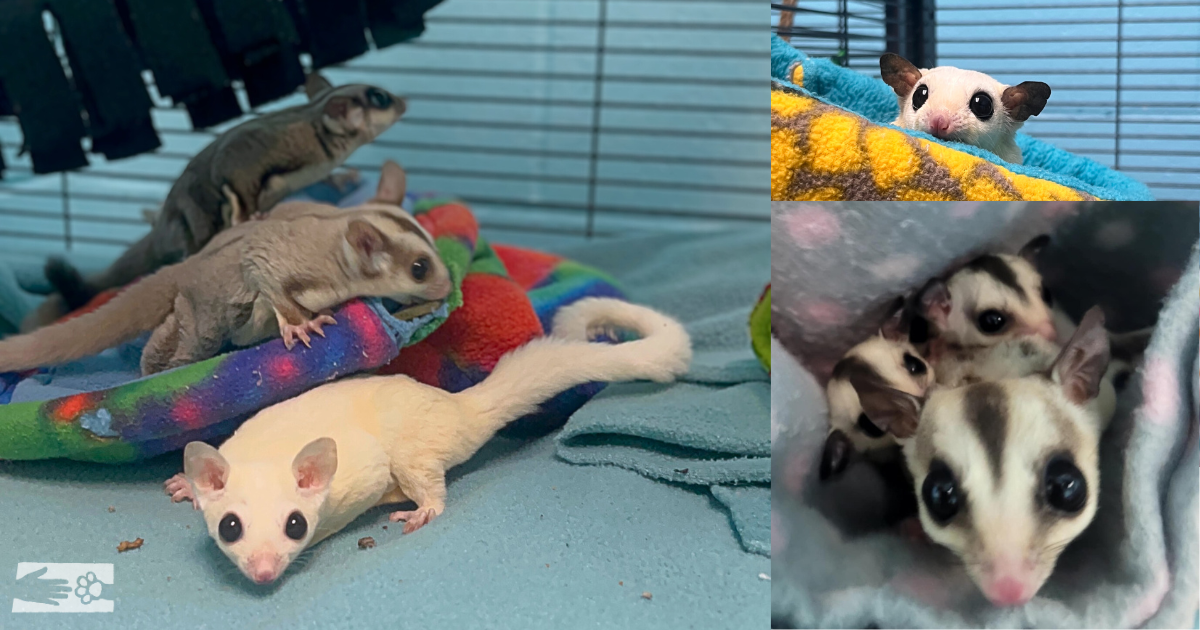All about Sugar Gliders

Sex:
Dogs:
Cats:
Kids:
House Trained:
Crate Trained:
Breed:
Age:
Reason Here:
Arrival Date:
Energy Level:
Size/Weight:
Special Considerations:
Curious about adopting a sugar glider? These exotic and virtually wild animals have very specific diet, exercise, houseing, handling, and enrichment needs. Read on below to learn more about these adorable, misunderstood creatures!
Fun facts about sugar gliders
- Sugar gliders are nocturnal! This means that they are most active overnight. Typically it’s best to ensure your glider has plenty of food overnight as that is when they will be awake!
- They can’t fly, they glide! They will leap off of tall places (or trees in the wild,) and glide to their destination
- Sugar gliders shouldn’t get wet or be given baths as it can make them sick! Unlike other small mammals who like dust baths, sugar gliders are like cats and do a fantastic job at bathing themselves
- Sugar gliders can live 12-15 years with proper husbandry, some even longer! They are a long commitment and will become very bonded to you!
- Sugar gliders are colony animals and need to be kept in pairs or groups of 2 or more for their mental well being. For this reason, sugar gliders adopted from HSCC must be adopted in pairs or groups (the only exception being adopters who have a single glider at home and wish to get a friend for them)
- When sugar gliders accept each other and mark one another as part of their colony, they grab the other glider’s face and rub their foreheads together! It’s adorable, and a good sign to know that your gliders are happily coexisting and bonded
Housing
Sugar gliders are very small animals that require specific enclosures. In the wild they spend all of their time in trees, and hardly ever touch the ground. Their enclosure should be tall, and have plenty of space for them to swing, jump, and bounce around! The bars on their cage need to be ½ inch or smaller as they can fit through anything bigger. They are also escape artists and have been known to figure out how to open more simple “locks” on some enclosures. Critter Nation cages are a great example of a safe enclosure, however there are many other alternative safe options as well! Sugar gliders should never be housed in aquariums.
Enrichment
There are lots of fun and safe sugar glider toys/hammocks you can buy or make with simple materials like fleece, plastic trinkets, and plastic c-clips! Sugar gliders should always have at least a couple of fleece pouches to hang in, as they typically prefer to sleep in these. Sugar gliders also love puzzles, hanging food toys, and toy boxes filled with small plastic trinkets and pompoms! Gliders also love to run on wheels and it’s a great form of exercise, however there are many wheels that are dangerous. Gliders tend to jump very high when running, so wheels with a bar in the center would be a concern for your gliders. Always look into what is safe for your gliders. There are many great Facebook groups with lots of support and ideas!
Diet
Sugar gliders have a complex diet as they have very fast metabolisms and require a variety of fruits, vegetables, and protein. There are a few different “recipes” for glider food, but the one most frequently used is The Pet Glider diet (TPG diet). This offers gliders a perfect balance of what they need to maintain a healthy weight and metabolism. It includes things like fresh fruits, veggies, yogurt, applesauce, protein (scrambled eggs, chicken, etc.) and a few additional items. There is a full recipe online under “TPG diet”. Additionally, gliders should always have access to glider kibble, and multiple fresh water sources. They prefer water bottles and also hanging bowls.
Bonding
Bonding with your sugar glider can be fun and exciting! Once they get to know you, they will recognize your voice, and greet you at the front of the cage. The best time to bond with your glider is during morning or late afternoon, as they will be very active during the night and very sleepy during the day! Some things you can do to get your sugar glider to start to recognize you are:
- Talk to them quietly. Learn their sounds as well–they’re very communicative and you will easily be able to tell what they are trying to tell you!
- Leave small items of your clothing in or near their cage
- Use a zipped bonding pouch to safely hold them in your shirt so they can get used to your smell
- Give them small amounts of occasional safe treats–mealworms, yogurt drops, dubia roaches
- Mesh bonding tents are a great way to give your glider more space to glide safely, and spend time with you!
Male vs. Female Gliders
Unneutered male sugar gliders will have obvious testicles as well as a bald spot on their head which is their scent gland. This gland is used to mark their territory and their colony members and they will rub it on things. It is highly recommended to get males neutered as intact male gliders are known to self-mutilate, as well as be more aggressive to other gliders. You should not house males and females together unless the males are neutered. There are VT vets who do this (surprisingly simple!) procedure, you just may have to call around! Female sugar gliders have a pouch that they keep their young in. They keep their babies in their pouch for quite a while before they are old enough to exit the pouch and start exploring with mom. The babies will nurse and depend on mom before they are able to start eating normal foods. Sugar glider pregnancies can be difficult as they are known to often reject babies, and it can be even more difficult if you have multiple gliders housed together as you will need to separate mom and babies from everyone else.
Common Concerns
- Dehydration: Gliders should always have access to multiple water sources as they are known to easily get dehydrated. Dehydration can happen quickly in gliders, so make sure to always check their bowls/bottles!
- Abscesses: Abscesses can be caused by a variety of things, but are commonly seen under the chin caused by dental issues. These should always be checked out by a vet, and can often be solved with intervention and medication.
Local Veterinary Resources for sugar glider guardians
Veterinary practices that can treat sugar gliders*:
*Please contact the practice to inquire if they are accepting new sugar glider patients
Adoption Center Hours:
Tuesday-Friday: 1PM - 5PM
Saturday: 12PM - 5PM
Sunday & Monday: Closed


